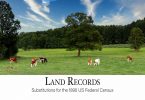The 1890 US federal census is not available to genealogical researchers. This is because it was destroyed in a fire in the 1930s. This leaves a large genealogical gap in the availability of the traditional records, from 1880 to 1900. It can be frustrating to lose access to this much potentially valuable genealogical information, especially for beginning genealogists. The good news is that there are other records that can help you bridge that gap. Maps are one of them. This is how to use them for a substitution for the 1890 US federal census.
There are a lot of different types of maps. While the larger ones like globes and atlases probably won’t do you much good in filling in information that would have been on the 1890 census, others will. These are smaller maps that are used at local levels, such as state and town levels.
What are some of the useful types of maps for a genealogist looking to bridge the gap left by the 1890 US federal census? These are some of the most promising ones.
Boundary Change Maps — These show how the borders of townships, counties, states, and US territories have changed over the decades and centuries. A boundary change map can assist you in discovering if your ancestors moved, or if the boundaries of where they lived moved. If you are missing ancestors in the 1900 census, the boundary change map from the 1890s will tell you where they are most likely located, even if they didn’t actually move.
City and Town Maps — Using maps of the cities and towns where your ancestors lived in the 1890s, you can usually determine their addresses, as well as tell if they still live in the same town you thought they did in the 1880 census, or if they have moved since that time. Because the names of individual homeowners are sometimes included on these maps, you can find out if your ancestors’ grown children have moved out, married, and/or are living in the same neighborhood, town, or city.
City Plan Maps — Street names change over time, as do the names of neighborhoods, parks, and other public places. A city plan map can help you locate your ancestor if the name of their street changed in the twenty year gap between the 1880 and 1900 censuses.
County or Parish Maps — If you are looking for ancestors who may have crossed over between the censuses, a county map will show the location of local cemeteries. This will give you the opportunity to get some ideas of where to look for their final resting place, and, with any luck, a headstone for your records and genealogical photos. If the date of death is between the 1880 and 1900 censuses, you will be able to find the exact date of crossing over on the headstone, if you know where to look for the stone in the first place.
Fire Insurance Maps — Also known as the Sanborn maps, there are 12,000 cities and towns around the United States that have them. These maps have street names, addresses, and even owners, beginning in 1867 and onward into the early 1900s. These are a classic map source for genealogists to use.




